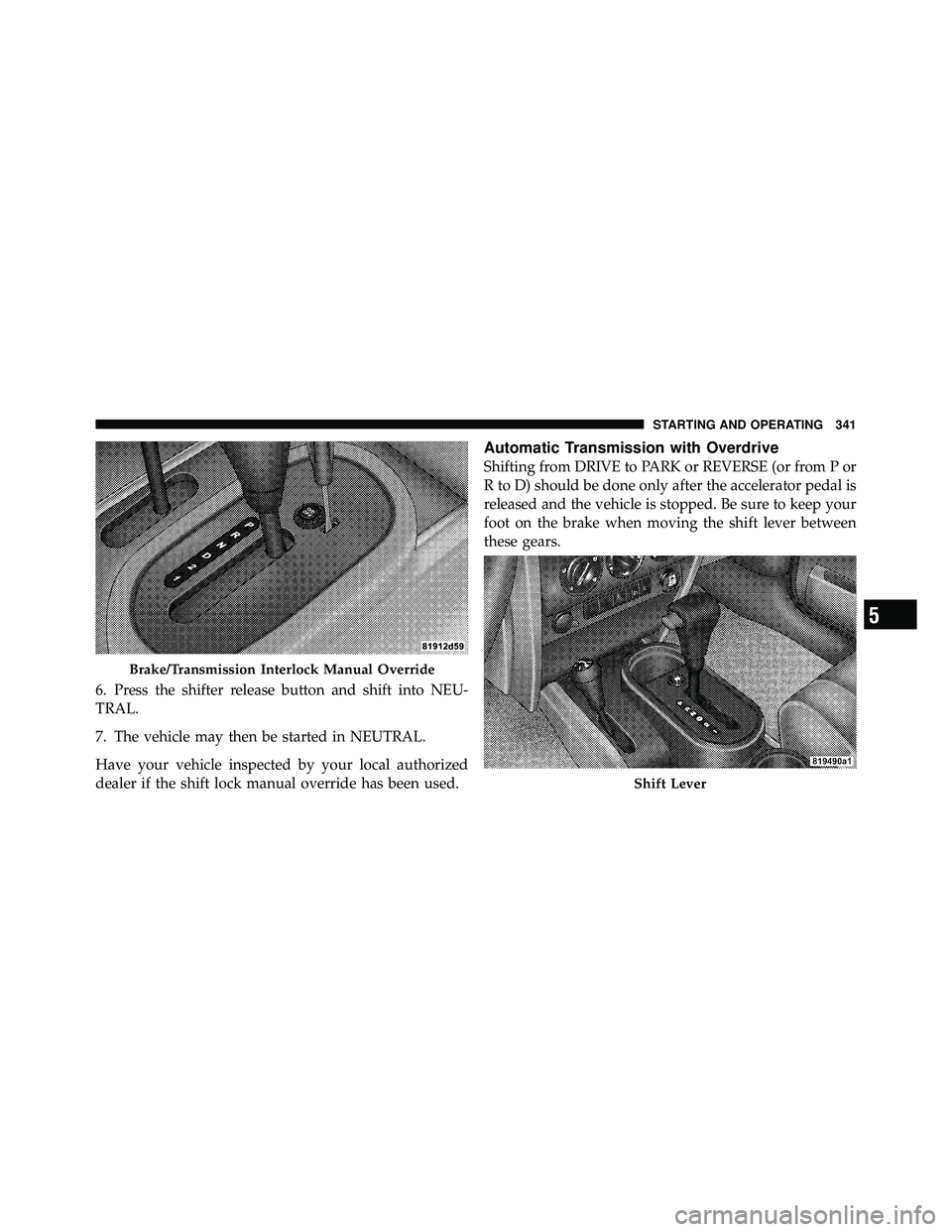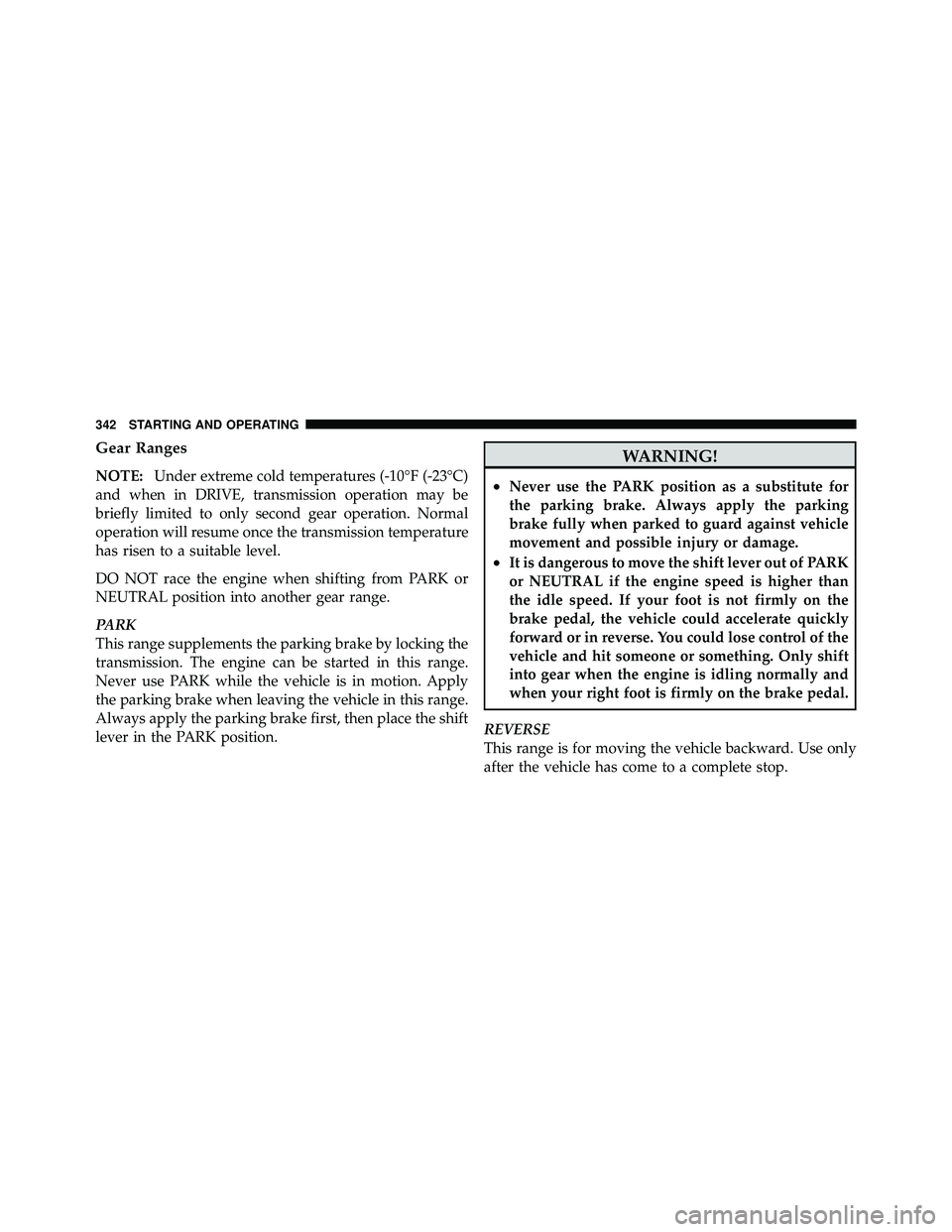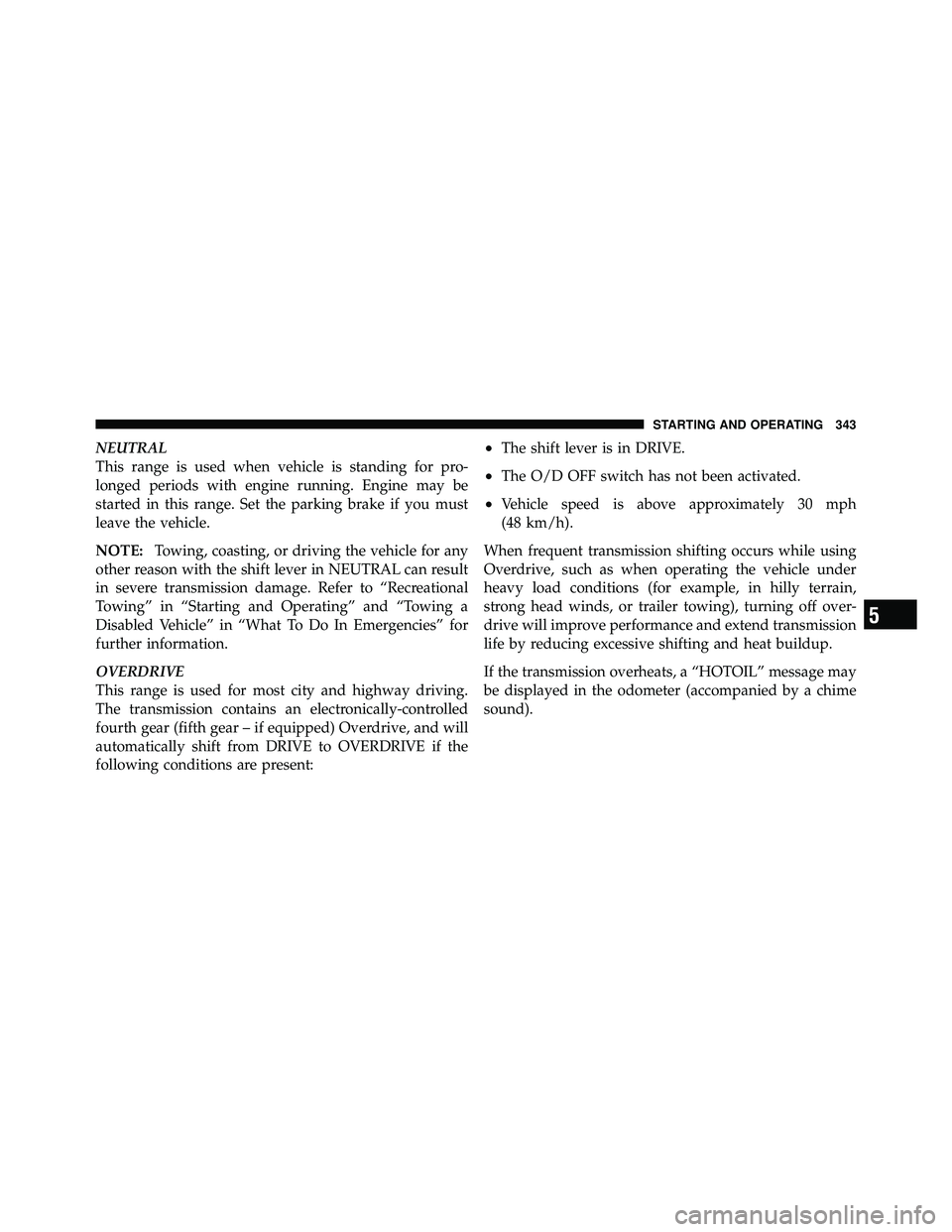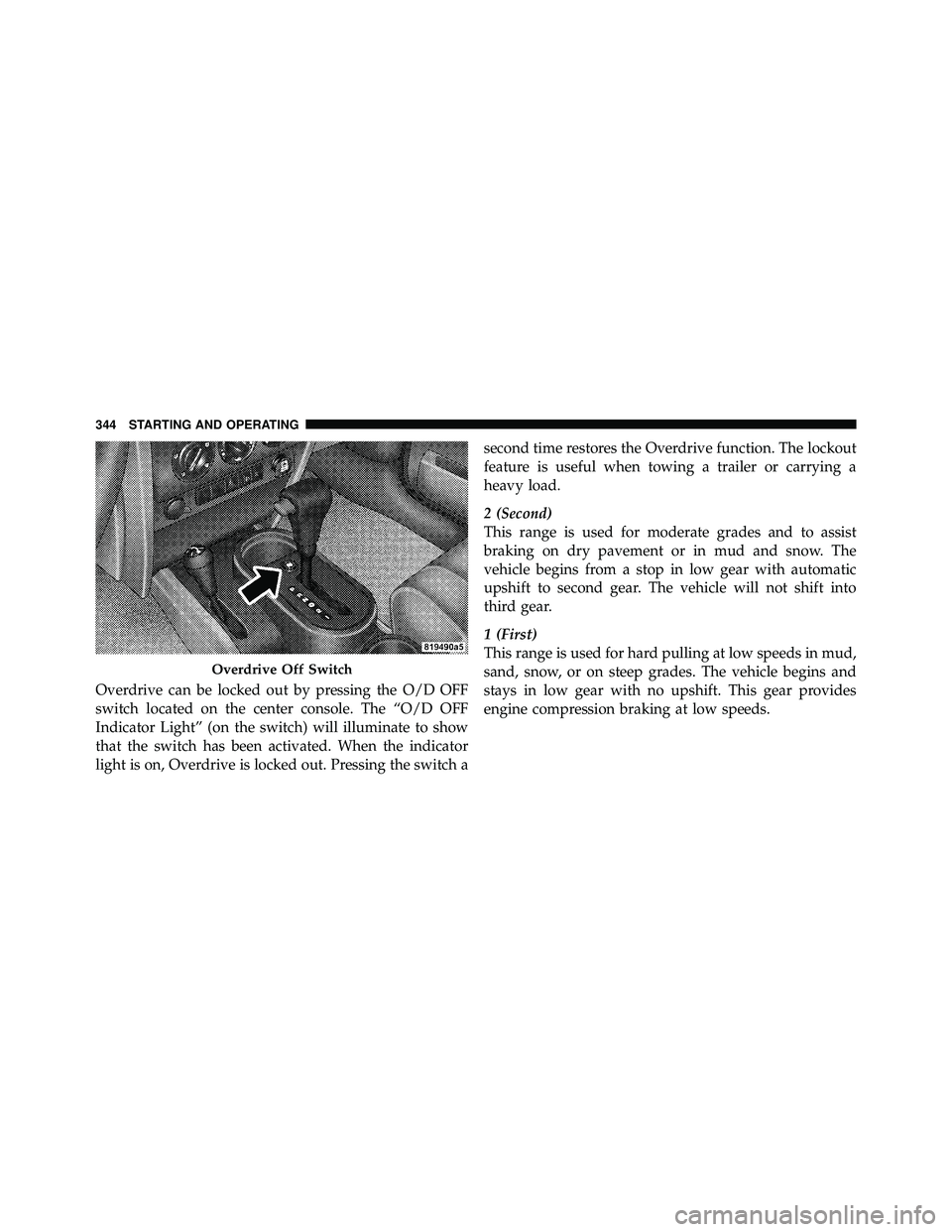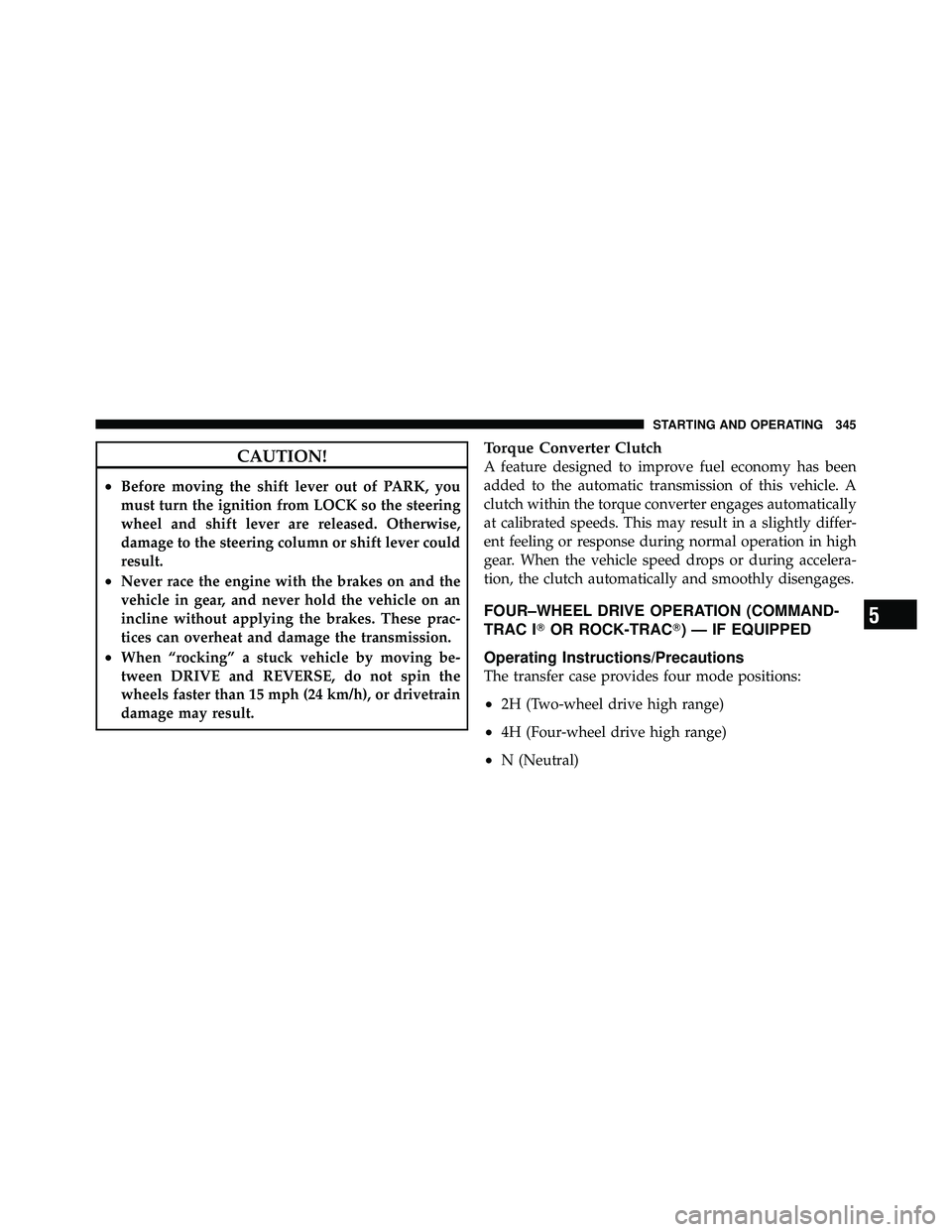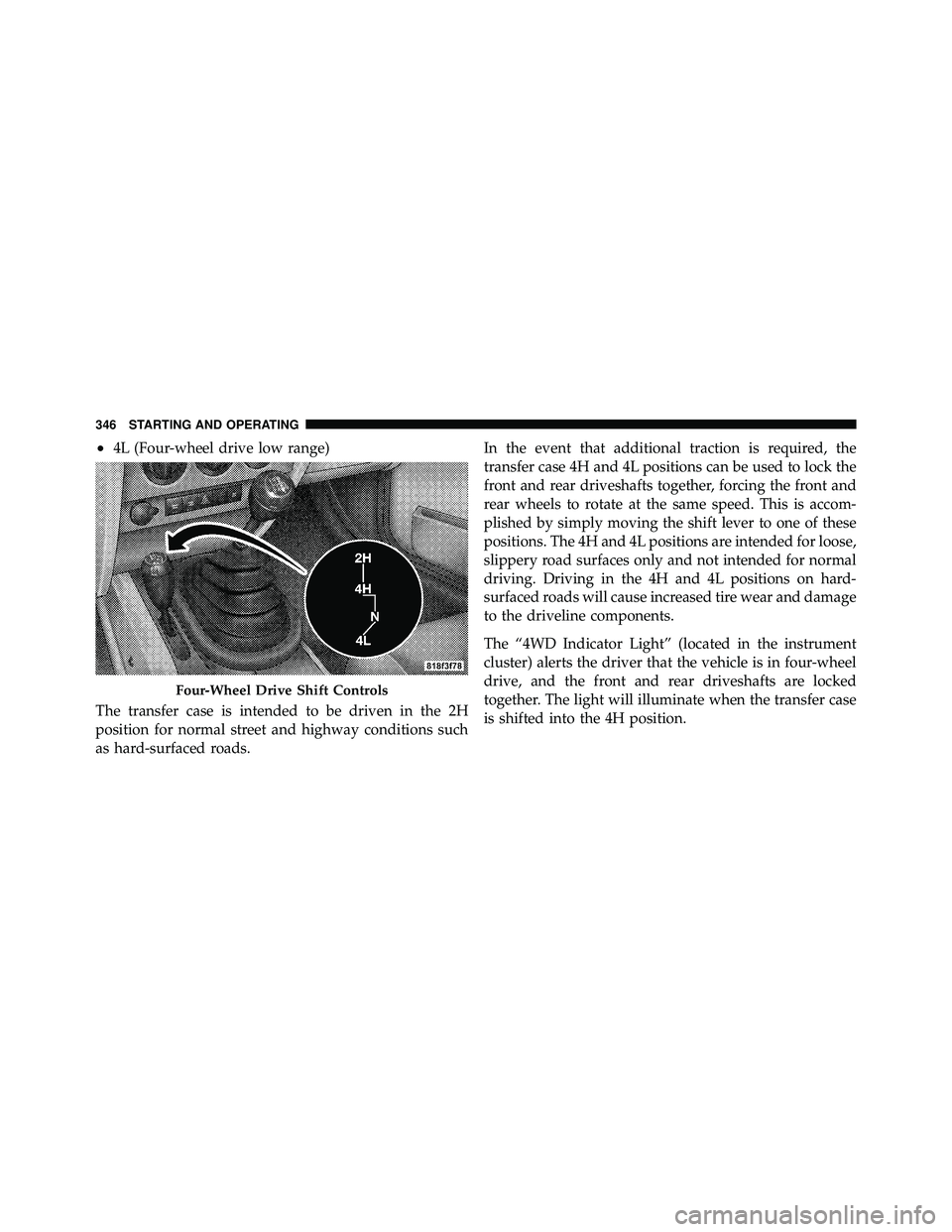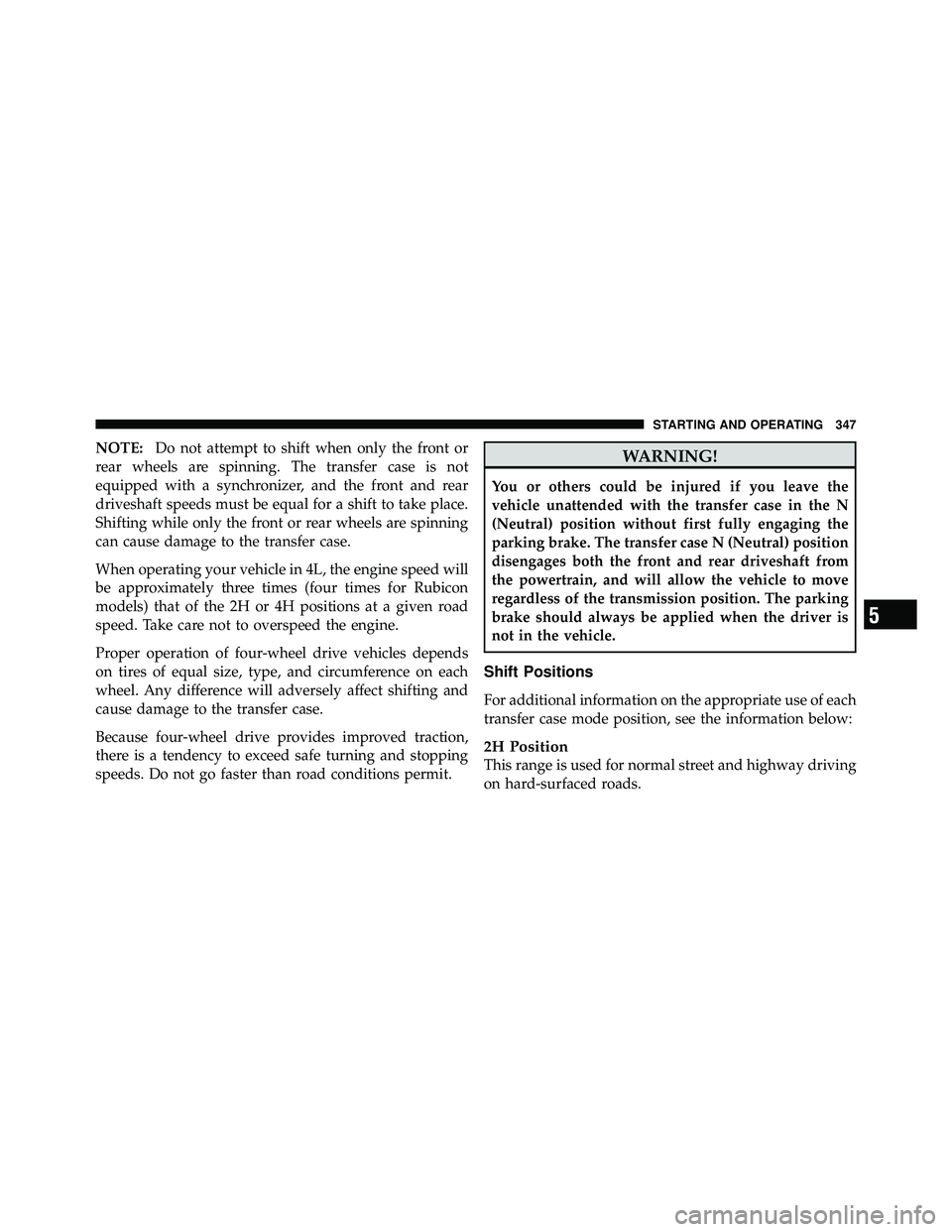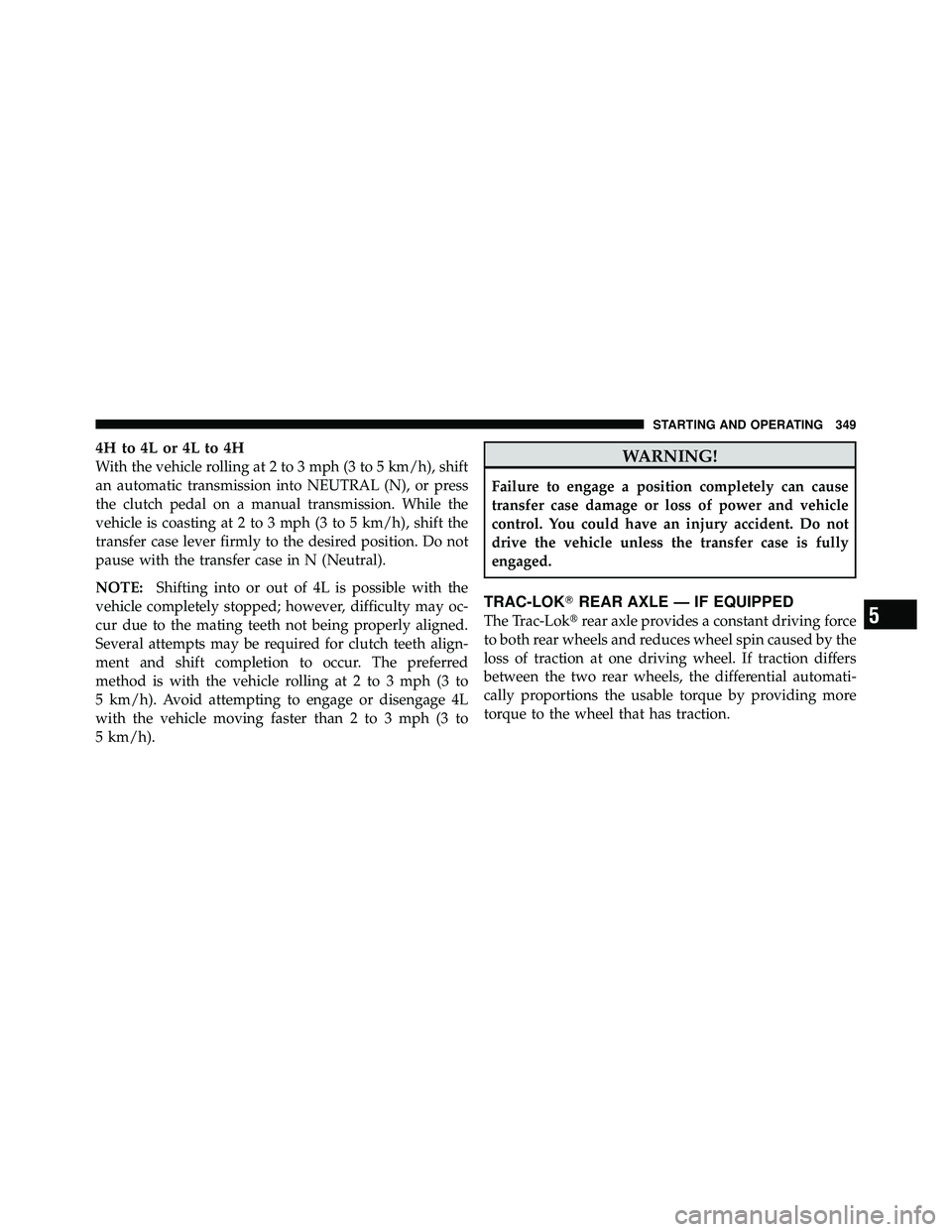JEEP WRANGLER 2010 Owners Manual
WRANGLER 2010
JEEP
JEEP
https://www.carmanualsonline.info/img/16/56059/w960_56059-0.png
JEEP WRANGLER 2010 Owners Manual
Trending: oil temperature, turn signal, wiper blades, gas type, air filter, trailer, airbag off
Page 341 of 554
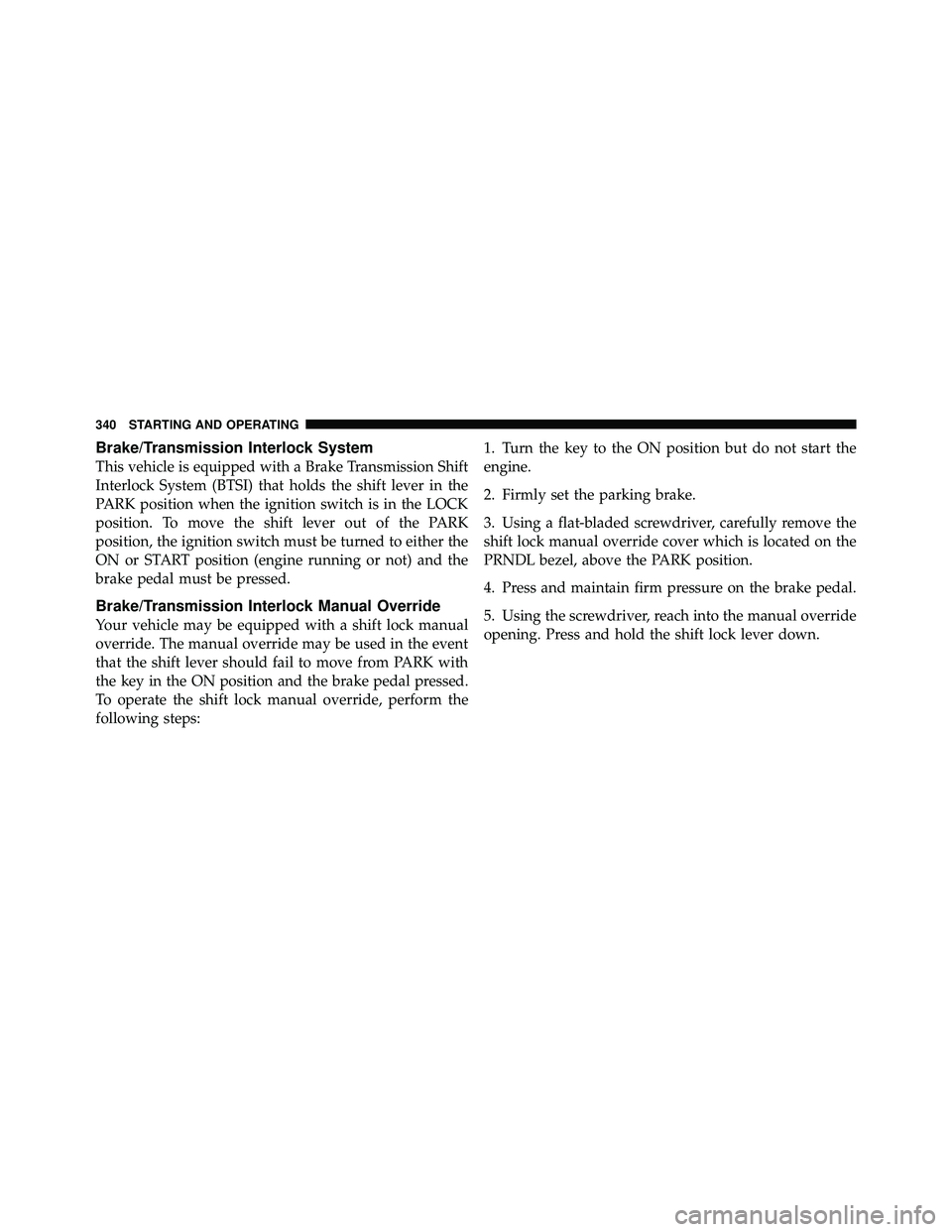
Brake/Transmission Interlock System
This vehicle is equipped with a Brake Transmission Shift
Interlock System (BTSI) that holds the shift lever in the
PARK position when the ignition switch is in the LOCK
position. To move the shift lever out of the PARK
position, the ignition switch must be turned to either the
ON or START position (engine running or not) and the
brake pedal must be pressed.
Brake/Transmission Interlock Manual Override
Your vehicle may be equipped with a shift lock manual
override. The manual override may be used in the event
that the shift lever should fail to move from PARK with
the key in the ON position and the brake pedal pressed.
To operate the shift lock manual override, perform the
following steps:1. Turn the key to the ON position but do not start the
engine.
2. Firmly set the parking brake.
3. Using a flat-bladed screwdriver, carefully remove the
shift lock manual override cover which is located on the
PRNDL bezel, above the PARK position.
4. Press and maintain firm pressure on the brake pedal.
5. Using the screwdriver, reach into the manual override
opening. Press and hold the shift lock lever down.
340 STARTING AND OPERATING
Page 342 of 554
Page 343 of 554
Gear Ranges
NOTE:Under extreme cold temperatures (-10°F (-23°C)
and when in DRIVE, transmission operation may be
briefly limited to only second gear operation. Normal
operation will resume once the transmission temperature
has risen to a suitable level.
DO NOT race the engine when shifting from PARK or
NEUTRAL position into another gear range.
PARK
This range supplements the parking brake by locking the
transmission. The engine can be started in this range.
Never use PARK while the vehicle is in motion. Apply
the parking brake when leaving the vehicle in this range.
Always apply the parking brake first, then place the shift
lever in the PARK position.
Page 344 of 554
Page 345 of 554
Overdrive can be locked out by pressing the O/D OFF
switch located on the center console. The “O/D OFF
Indicator Light” (on the switch) will illuminate to show
that the switch has been activated. When the indicator
light is on, Overdrive is locked out. Pressing the switch asecond time restores the Overdrive function. The lockout
feature is useful when towing a trailer or carrying a
heavy load.
2 (Second)
This range is used for moderate grades and to assist
braking on dry pavement or in mud and snow. The
vehicle begins from a stop in low gear with automatic
upshift to second gear. The vehicle will not shift into
third gear.
1 (First)
This range is used for hard pulling at low speeds in mud,
sand, snow, or on steep grades. The vehicle begins and
stays in low gear with no upshift. This gear provides
engine compression braking at low speeds.
Page 346 of 554
Page 347 of 554
•4L (Four-wheel drive low range)
The transfer case is intended to be driven in the 2H
position for normal street and highway conditions such
as hard-surfaced roads. In the event that additional traction is required, the
transfer case 4H and 4L positions can be used to lock the
front and rear driveshafts together, forcing the front and
rear wheels to rotate at the same speed. This is accom-
plished by simply moving the shift lever to one of these
positions. The 4H and 4L positions are intended for loose,
slippery road surfaces only and not intended for normal
driving. Driving in the 4H and 4L positions on hard-
surfaced roads will cause increased tire wear and damage
to the driveline components.
The “4WD Indicator Light” (located in the instrument
cluster) alerts the driver that the vehicle is in four-wheel
drive, and the front and rear driveshafts are locked
together. The light will illuminate when the transfer case
is shifted into the 4H position.
Page 348 of 554
Page 349 of 554
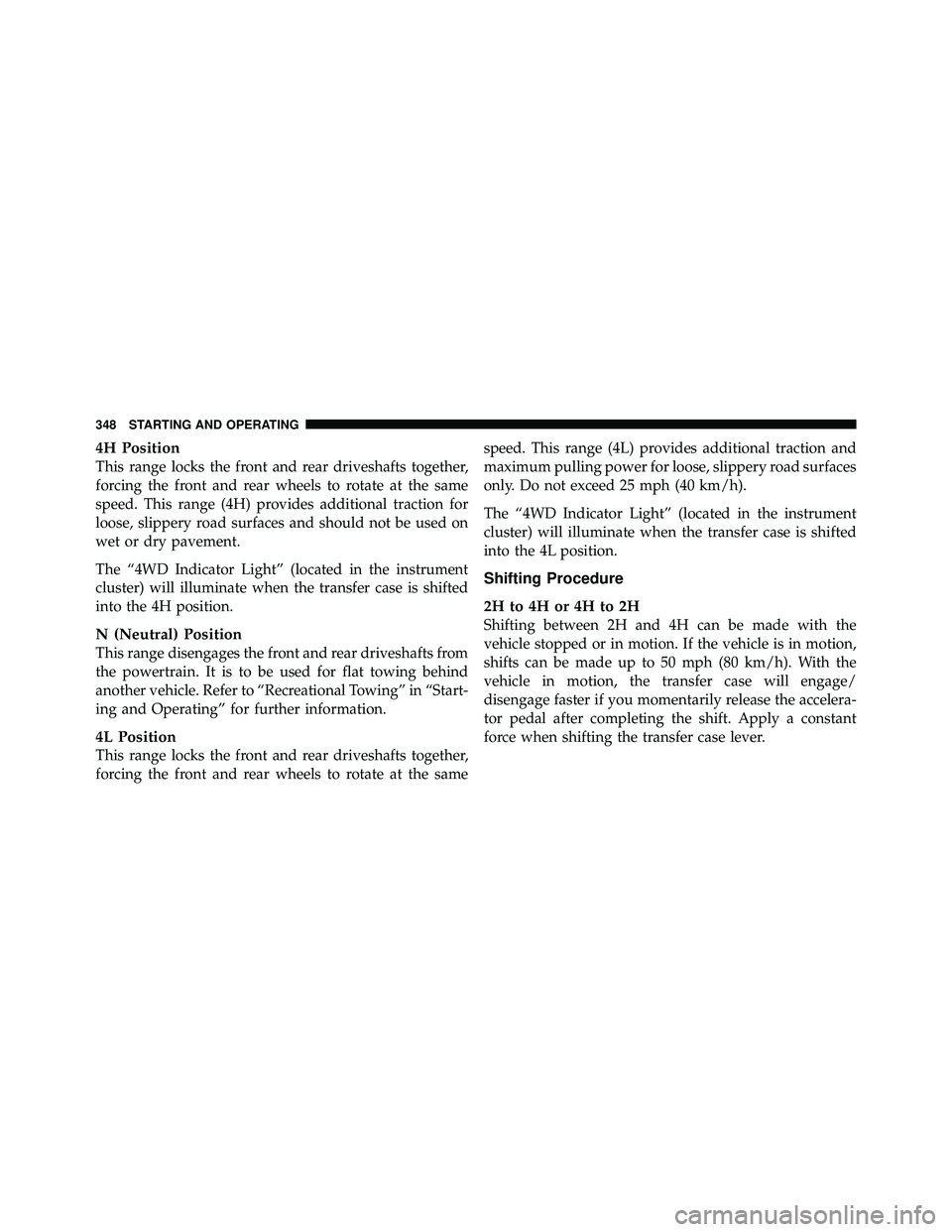
4H Position
This range locks the front and rear driveshafts together,
forcing the front and rear wheels to rotate at the same
speed. This range (4H) provides additional traction for
loose, slippery road surfaces and should not be used on
wet or dry pavement.
The “4WD Indicator Light” (located in the instrument
cluster) will illuminate when the transfer case is shifted
into the 4H position.
N (Neutral) Position
This range disengages the front and rear driveshafts from
the powertrain. It is to be used for flat towing behind
another vehicle. Refer to “Recreational Towing” in “Start-
ing and Operating” for further information.
4L Position
This range locks the front and rear driveshafts together,
forcing the front and rear wheels to rotate at the samespeed. This range (4L) provides additional traction and
maximum pulling power for loose, slippery road surfaces
only. Do not exceed 25 mph (40 km/h).
The “4WD Indicator Light” (located in the instrument
cluster) will illuminate when the transfer case is shifted
into the 4L position.
Shifting Procedure
2H to 4H or 4H to 2H
Shifting between 2H and 4H can be made with the
vehicle stopped or in motion. If the vehicle is in motion,
shifts can be made up to 50 mph (80 km/h). With the
vehicle in motion, the transfer case will engage/
disengage faster if you momentarily release the accelera-
tor pedal after completing the shift. Apply a constant
force when shifting the transfer case lever.
348 STARTING AND OPERATING
Page 350 of 554
Trending: charging, alarm, height adjustment, brake fluid, manual transmission, TPMS reset, door lock

